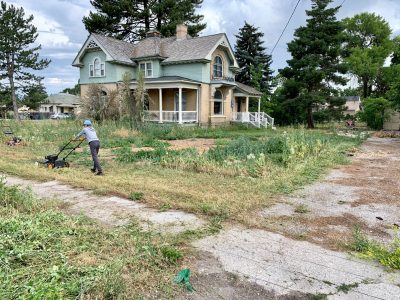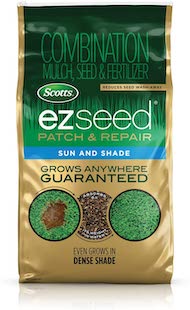The health of your lawn is vital to the appearance of your property. I have purchased grass seed to spruce up my front lawn. I applied the grass seed to patches of grass that have a hard time growing. But, even after applying the grass seed, the grass is not growing in spots. I researched to find the best and easy solutions to this common problem.
Why is my grass seed not growing in certain spots? The simple answer would be not enough moisture to the soil. If it’s been hot and dry and you have watered just enough to wet the surface the seed hasn’t had enough moisture to start the germination process, especially in hard clay.
You want to begin with a deep watering of the soil (be careful not to over water) and then apply the grass seed. Next, cover the seed with a layer of protection. Some examples are oat straw, screened compost, or dirt. This layer of protection needs to be thin. Then, water the seed for 5 to 10 minutes at least twice a day. You want to do this more often if your climate is hot and dry. After these steps, many grass seeds germinate overnight.
Although lack of moisture is the most common downfall when planting grass seed, there are several explanations as to why you might have complications. In this post, we will answer the difficult questions and more, providing you with everything you need to know about grass seed obstacles. This information can also be useful for those wanting to begin using grass seeds to improve their lawn care.
Understanding & Fixing Grass Seed Complications
To begin with, when it comes to perfecting the health of your lawn, the solutions are often simple and require short easy steps. The most effective and efficient way to conquer the issue of grass seed not growing is to find and understand the root of the problem. Taking these first steps and finding the distinct issues will result in flawless results.
Avoiding Common Grass Seed Mistakes
Producing a lush, vibrant lawn takes commitment, but the results of a successful grass seed project are worth the time and assets you invest. A healthy lawn can increase your home’s value, benefit the environment, and enhance your family’s quality of life. Even if this is your first time taking steps to improve the health of your lawn, you can avoid these common mistakes:
Planting the Wrong Seed
There is a wide range of grasses, with each of them having their own preferences and tolerances. Finding the appropriate grass variety is vital to the health and appearance of your lawn. For example, Kentucky bluegrass and Bermudagrass are significantly different in climate and maintenance requirements.
Certain types of grass grow in sandy soil while others do not. Your growing region has its own grass variety. Finding and planting the specific grass variety gives your seed a natural advantage.
All grass seed is not equal, even when it comes to similar seed types. Researching what is actually in the bags of seed you or your lawn professional buy is significant. With that, by understanding the seed analysis or seed tags on grass seed products, you can be sure to invest in quality grass seed. When it comes to cheaper price tags, you can expect old seeds past their prime, more weed seeds, lower germination rates, and more filler to seed ratio.
What is a Seed Tag?
According to Pennington products, “Every bag of seed in your local store has what’s known as a seed tag or seed-analysis tag attached. Thanks to the Federal Seed Act1 and state seed laws, every seed product must carry standard, uniform information to prevent misrepresentation and help consumers make informed choices.
On bags weighing 15 pounds or less, seed tags are usually printed on the back of the bag, at the bottom. On larger bags, tags are sewed into the bag’s top seam. On jugs of seed, you’ll find the seed tag printed on the side panel. Understanding a seed tag isn’t very complicated once you learn what it provides.”
A seed tag provides the following information:
- Seed Product Name
- Net Weight of Bag/Container
- Pure Seed
- Variety and Kind
- Germination Rate
- Origin
- Other Crop Seed
- Inert Matter
- Weed Seed
- Noxious Weed
- Guaranteed Analysis
- Lot Number
- Test Date
- Sell-by Date
- Name and Address of the Seed Company
Skipping the Soil Test and Recommendations
When it comes to seeding success, it is essential to know how your soil reacts to certain conditions. In addition, understanding the soil pH and plant nutrients allows you to accurately select the correct resources to achieve your dream lawn. Soil testing processed through a reputable soil laboratory eliminates estimates and provides you accurate answers you need when acquiring products.
Without knowing the health of your soil, fertilizers can harm grass growth rather than help. Applying your distinct soil lab recommendations helps avoid potential obstacles and unnecessary setbacks. Turf professionals emphasize soil testing for successful seed germination and healthy, vibrant looking lawns. Your local county extension office can help with testing kits and lab referrals.
Planting Without Regard for Proper Timing
It can be hard not to resolve a patchy lawn in front of. your home, office, or law firm as soon as the problem arises. But proper timing is crucial for great results. Grass growth occurs in seasonal cycles, this varies with different regions. Timing your grass seed projects to coincide with growing cycles increases your rate of success.
For most of the United States, fall is the best season to plant grass seed. Cool-season grasses such as Kentucky bluegrass and tall fescues peak in growth during this season. This is due to the climate conditions. Proper timing also results in less input of resources and less maintenance. Also, the conditions heighten germination which leads to successful developments.
Missing an Area
When applying grass seed, it is very common for the spreaders to miss some areas. It is important to keep a close eye on the affected site for the next 4 to 7 days. If there is no germination, this could be a sign that the spots were missed or there could be complications with your spreader. After planting, performing a thorough follow-up to the site can ensure an even spread of the grass seed.
Too Much Rain
Due to unpredictable weather, grass seeds can sometimes move due to heavy rains. The rain moves the seeds to low spots of the lawn, leaving the high spots with little to no germination. When this occurs, tilling and replanting the grass seeds can aid in your desired lawn results.
Avoid Dry Grass Seeds
Although, too much water can be detrimental, too little can result in your grass seeds drying out. Ensure that when you are planting your grass seeds to make sure they are not right on the surface. This causes them to dry out quickly. Covering your seeds with a thin layer of dirt will allow the seeds to stay moist and absorb the nutrients from the soil. Also, if you are not able to water the site multiple times a day, planting the seeds in partial shade will help the soil to dry slower.
Be Mindful of Pests
Finally, if you have tried seeding several times, your answer could be small pests in your grass. Some areas are more prone to pests than others, be aware of planting near a wooded area. Wooded areas are populated with wildlife that loves to prey on your freshly planted grass seed. Placing bait down for your predators has had great results for grass growth.
With these easy tips, you can effectively fix grass seed not growing in certain spots. You can find more helpful lawn care tips here!


